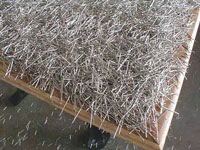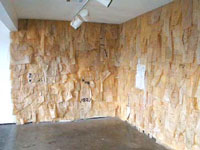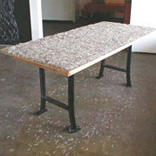Breathe, Sarah Nix Ginn’s new show at Diverseworks’ Subspace Gallery, departs from the sculptural works featured in her last few shows to struggle with process art and installation, using her familiar imagery relating to sewing. Ginn is visibly searching for a combination of materials, images and presentation styles that will articulate her feelings.

Obviously sewing means something to her, but the pieces in Breathe fail to say what. It’s as if she’s trying out various types of art, choosing sewing as an arbitrary theme for demonstration purposes. Ginn struggles unsuccessfully to piece together a coherent metaphor from a table covered in pins, a wall of collaged clothing patterns, and a wall drawing of a dressmaker’s wire dummy.
Near the center of the gallery stands a worktable covered in shiny pins about an inch deep. A few pins have been scattered on the floor around the table, as if they had fallen off the edges. What’s the story? It is difficult to criticise a work for not being what it could have been, when you can’t decide what it was trying to do in the first place. The pins are spread too evenly to have fallen from above like rain. They haven”t accumulated over the years of toil; they’re all brand new. It looks as if the artist had brought in a table, poured pins onto it from a big box. Nothing more, nothing less. Ginn could have used fifty pounds of pins or just fifty pins. She could have flung them from across the room, or carefully placed them with tweezers, but she didn’t. Lacking clear intention, the piece leaves the viewer in limbo.
Ginn’s largest piece is a wall of paper clothing patterns which wraps around one corner of the gallery. Overlapping one another like shingles, the hanging pattern pieces sway and rustle in the breeze from an overhead fan. Ginn’s main interest in the pattern pieces seems to be formal: the translucent delicacy of tissue paper combined with the appealingly purposeful printed cutting lines and instructions. Like floor plans, engineering specs, and nautical charts, dress patterns have a sense of purpose which is especially appealing to artists who are struggling with airy metaphors. Ginn attempts to appropriate this pragmatism but, as with the pin table piece, the parts don’t match up: the wall of rustling tissue paper recalls leaves, the surface of a piñata or an untidy architectural office, but none of these images is particularly resonant.
The best pieces in the show are the four small prints interspersed with the installation scale works. Energetic, scratchy lines and rich black ink combine with competent draftsmanship to make appealing semi-abstractions, based on a wire dress form. In these works, Ginn sets aside her struggle with the complex variables of installation work, using the prints” unpretentious scale and traditional medium to provide a readymade vehicle for her formal explorations.
Eye Dazzlers: Native American Blankets from theCollection of Tonia and Bob Clark
Brazos Projects (2425 Bissonnet St.)
Everybody knows Navajo blankets are great. Liking them is like applauding a sunset. But go see Eye Dazzlers at Brazos Projects. It’s a chance to see six museum-quality Navajo and Zuni blankets from the 1880s and 90s in a setting far more intimate than a museum. The blankets are in incredible condition; they seem new. It’s worth it. Go.
As a contemporary artist, I look at these blankets with envy. I envy their self-assurance, their beauty, their irrelevance to distinctions between high and low art. I refuse to resort to supernatural explanations for the serene power of these works, but it is difficult to account for them otherwise. The best of them are religious experiences. I’m missing something if I talk about them in terms of the psychology of color perception. The artists who made blankets #1, 2, 3 & 6 understood something fundamental about life, death, the universe et al. in a way I can’t. They are made with the assurance of an intact cultural tradition, invigorated by a historical moment in which two cultures were edging into each other. I’m a confused, alienated product of a complex, unstable culture, and my art shows it. I can’t make Navajo blankets. (Except blankets 4 & 5, which are far more run of the mill. I could have made those two.)
Images appear courtesy the artists and galleries.
Bill Davenport is an artist and writer and was one of the first contributors to Glasstire.







1 comment
“I’m a confused, alienated product of a complex, unstable culture, and my art shows it.”
I’m enjoying this so much, thank you. Going back and forth between old and new. Read this right after Michael’s Ghost Dance. The last few sentences makes it feel like they are writing two versions of the same problem.
Love that he turns the old -my kid could do that- into an updated -I could do that- as an insult.
It’s weird that there are often two disjointed reviews in the Tire Irons. I’m sure it made sense in 2001, though.
test